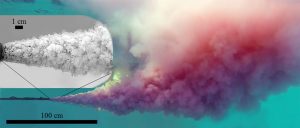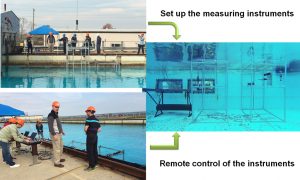Study Details Underwater Oil Plume Formation and Droplet Size Distribution
– AUGUST 10, 2016
Scientists simulated an underwater blowout to analyze the formation, path, and duration of oil plumes. They noted that the simulated blowout formed two plumes, one due to momentum and plume buoyancy and another due to the buoyancy of individual oil droplets separating from the first plume.
They also observed that oil plumes form through a two-step process: first, relatively large ligaments of connected oil develop a few inches from the release point in a process called the “primary breakup” and are then entrained back into the plume for their “secondary breakup” into droplets. They published their findings in the Chemical Engineering Journal: Underwater oil jet: Hydrodynamics and droplet size distribution.
The transport of oil spilled in surface waters has been well-documented, however much less is understood about submerged oil blowouts. Oil from submerged blowouts interacts more closely with the water column, and droplet size distribution greatly influences the oil’s subsequent transport and fate in the marine environment. The researchers released jet fuel oil, which has similar properties to Deepwater Horizon crude oil, at 100 gallons per minute through a 1-inch horizontal pipe into a seawater-filled tank to better understand how plumes evolve. They filmed the resulting formation of oil droplets using a high-resolution camera.
The team used their experiments to validate the VDROP-J model, determining that it confidently predicted the Deepwater Horizon spill oil droplet size distribution. They found that the observed primary breakup of oil was dependent on the turbulent shear stresses at the jet’s outer boundary, while the secondary breakup was dependent on oil properties, such as viscosity and oil-water interfacial tension, and mixing energy. The primary breakup was also found to be a key factor when quantifying droplet size distribution. They theorized that plume dynamics must be accounted for when adding dispersants to a blowout to reduce oil droplet size, as the oil plume’s highly varied velocity field could cause uneven dispersant effectiveness on oil droplet breakup.
Study author Michel Boufadel explained why determining oil droplet size distribution is a major goal for oil spills and blowouts, “The size of an oil droplet plays a major role in where it goes, as the larger the oil droplet, the greater its buoyancy. Larger oil droplets rise rapidly to the surface, while smaller oil droplets – those half a millimeter or less – tend to be carried horizontally through the water and could linger for months in the water column.”
Data are publicly available through the Gulf of Mexico Research Initiative Information & Data Cooperative (GRIIDC) at https://data.gulfresearchinitiative.org (doi:10.7266/N7D798DN). Supplementary data associated with this article can be found, in the online version, at http://dx.doi.org/10.1016/j.cej.2016.04.061.
The study’s authors are Lin Zhao, Franklin Shaffer, Brian Robinson, Thomas King, Christopher D’Ambrose, Zhong Pan, Feng Gao, Richard S. Miller, Robyn N. Conmy, and Michel C. Boufadel.
************
This research was made possible in part by a grant from the Gulf of Mexico Research Initiative (GoMRI) to the Dispersion Research on Oil: Physics and Plankton Studies II (DROPPS II) consortium. Other funding sources included Bureau of Safety and Environmental Enforcement (Project # 1027) and the Department of Fisheries and Ocean Canada (F5211-130060).
The Gulf of Mexico Research Initiative (GoMRI) is a 10-year independent research program established to study the effect, and the potential associated impact, of hydrocarbon releases on the environment and public health, as well as to develop improved spill mitigation, oil detection, characterization and remediation technologies. An independent and academic 20-member Research Board makes the funding and research direction decisions to ensure the intellectual quality, effectiveness and academic independence of the GoMRI research. All research data, findings and publications will be made publicly available. The program was established through a $500 million financial commitment from BP. For more information, visit https://gulfresearchinitiative.org/.
© Copyright 2010- 2017 Gulf of Mexico Research Initiative (GoMRI) – All Rights Reserved. Redistribution is encouraged with acknowledgement to the Gulf of Mexico Research Initiative (GoMRI). Please credit images and/or videos as done in each article. Questions? Contact web-content editor Nilde “Maggie” Dannreuther, Northern Gulf Institute, Mississippi State University (maggied@ngi.msstate.edu).







